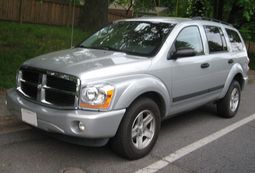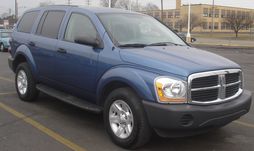The History Of Dodge Durango

The Dodge Durango is a full-size SUV from Chrysler's Dodge brand. It was introduced in 1998 as a mid-size SUV, and as a replacement for the Ramcharger discontinued in the North American market in 1993, and was redesigned for 2004. The Durango was produced at the Newark Assembly plant in Newark, Delaware until the end of 2008.
The Durango was launched just after the second generation Dodge Dakota on which it was based. During the late 1980s, Chrysler designers had proposed building an SUV version of the Dakota pickup[citation needed], but this was shelved when the Jeep division was about to release the Jeep Grand Cherokee as their flagship SUV. The Durango was marketed as a sturdy truck-based SUV designed to hold up to seven passengers and tow up to 6,700lb (3,039kg). The 4.7L PowerTech V8 replaced the 5.2L engine for 2000. In that same year a special all wheel drive performance version called the R/ T was released with a 5.9L V8 engine.
2001 saw a few revisions, including a redesigned interior, including a new dash, door panels, and revised seats. Other minor changes redesigned aluminium wheels, and minor changes to trim options.
Trim levels
- 1998-2003 - SLT
- 1998-2003 - SLT PLUS
- 1999-2001 - Sport
- 2001-2003 - SXT
- 1999-2003 - R/ T
Engines
- 1998–2000 — 5.2L (318cuin) Magnum V8, 230hp (172kW)
- 1999–2000 — 3.9L (238cuin) Magnum V6, 175hp (130kW)
- 1998–2003 — 5.9L (360cuin) Magnum V8, 245hp (183kW)
- 2000–2003 — 4.7L (287cuin) PowerTech V8, 235hp (175kW)
2004–2006
The second generation Durango debuted shortly before the companion Dakota. Like the Dakota, it has much in common with the large Dodge Ram pickup, including a fully-boxed frame. And like the first generation model, its front grille resembles the Dakota's. It is 7in (177.8mm). longer, 2in (50.8mm). wider, and 3in (76.2mm). taller than the previous model. For this model year, it offered a full third row with three seats, making the Durango an 8 Passenger SUV. The design has also has taken styling cues from the Dodge Powerbox concept as the design look similar except that the front fascia is more normal while the Powerbox had a different look. Chrysler introduced its own version of the Durango, the Chrysler Aspen, for the 2007 model year. The Durango became nearly a full-size SUV this time — although technically it is still classified as mid-size, and the upcoming Dodge Journey on the Avenger platform filled Dodge's mid-size SUV gap as a 2009 model.
2007–2009
The 2007 model was reworked to halt a sales decline, debuting at the Dallas Auto Show in April 2006. It includes a reworked front clip with a new fascia, grille, hood, and headlamps as well as updated fenders and wheels. New features include electronic stability program, tire pressure monitoring system, rear park assist, and a one-touch turn signal. The 2007 model also has a reworked floor, third-row seats, and electrical system in preparation for the 2009 hybrid version.
Hybrid
Chrysler started to build the Dodge Durango Hybrid 2009 in fall 2008, featuring the 340hp (254kW) 5.7L (≈348cuin) Hemi engine with MDS as well as the new Two-Mode Hybrid system developed with General Motors and BMW. The manufacturer claimed an almost 25% gain overall fuel fuel economy and an almost 40% gain in the city. EPA testing on the Hybrid Durango with the Hemi V8 engine indicates fuel mileage to be about 20miles per US gallon (12L/ 100km; 24mpg-imp) (city) and 22miles per US gallon (11L/ 100km; 26mpg-imp) (highway) for 2009 model. The normal (non-hybrid) Durango with the 5.7L Hemi and 4WD gets 13miles per US gallon (18L/ 100km; 16mpg-imp) (city) and 19miles per US gallon (12L/ 100km; 23mpg-imp) (highway).
The 2009 Dodge Durango Hybrid has a starting MSRP of $45,340. Production of the hybrid models (this included Chrysler Aspen Hybrid as well) began on August 22 2008. Chrysler received approximately 3000 pre-orders from dealers. By early November 2008, 400 of the hybrid S.U.V.’s, including Chrysler Aspen, had already been built.
Discontinuation
On October 23, 2008, Chrysler announced that the shutdown of the Newark Assembly facility producing the Dodge Durango and Chrysler Aspen would be moved up to the end of 2008, effectively ending production of the Durango and Durango Hybrid for the 2009 model year.
Trim levels
- SXT 2004-2009
- SLT 2000-2009
- SLT Plus 2002-2009
- Night Runner 2005-2007
- Limited 2004-2009
- Adventurer 2005-2008
Engines
- 2004–2009 - 3.7L PowerTech V6, 210hp (157kW) at 5200rpm and 235lb·ft (319N·m) at 4000rpm
- 2004–2007 - 4.7L PowerTech V8, 235hp (175kW) at 4500rpm and 300lb·ft (407N·m) at 3600rpm
- 2004–2009 - 5.7L Hemi V8, 335hp (250kW) at 5200rpm and 370lb·ft (502N·m) at 4200rpm (MDS [Multi-Displacement System] equipped for 2006+ 5.7L engines for improved fuel mileage)
- 2007-2009 - 4.7 L flex-fuel PowerTech V8, 235hp (175kW) at 4500rpm and 300lb·ft (407N·m) at 3600rpm
- 2008-2009 - 4.7 L PowerTech V8, 303hp (226kW) at 5,650rpm and 330lb·ft (447N·m) at 3,950rpm (3 valves per cylinder)
Chrysler will eventually reintroduce the Durango on a car based platform that will be shared with the 2010 Jeep Grand Cherokee and the next Mercedes-Benz M-Class.
From Wikipedia, the free encyclopedia
More About Dodge Durango




|